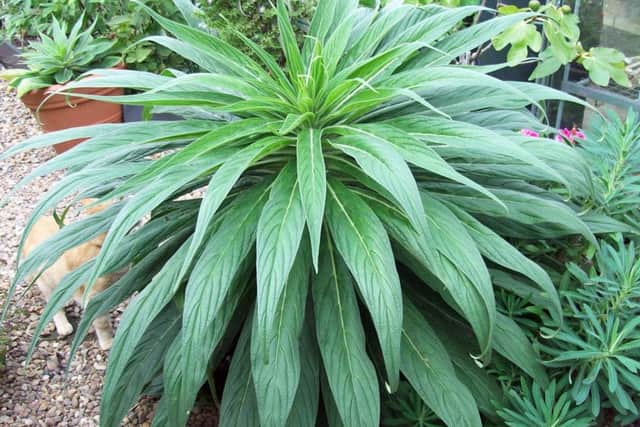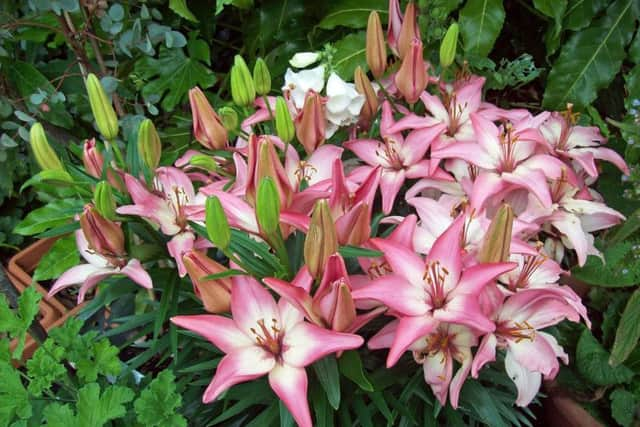Gardening: Exotic, dramatic and tall '“ that's the Echium
This article contains affiliate links. We may earn a small commission on items purchased through this article, but that does not affect our editorial judgement.


Our native variety, E. vulgare, (viper’s bugloss), is loved by bees but I’m a massive fan of its bigger brothers and sisters, mostly natives of the Canary Islands.
Don’t let this put you off – I’ve grown them from seed (easy) for the past few years and they have survived the North East winter well, as long as they’re kept in free-draining soil.


Advertisement
Hide AdAdvertisement
Hide AdThey flower in their second or third year and as prolific self-seeders (especially E. pininana), you’ll never be without these whoppers. For a small garden, they don’t take up much ground space – it’s all in the flower spike, which grows like a rocket in late spring.
Here are the best with flower spike heights:
Echium pininana (3-4. metres): There are three colours, Pink Fountain, Blue Steeple and Snow Tower - blue, pink and white. Drought tolerant and although they droop in a frost, they soon perk up as temperatures rise. They will tolerate a couple of nights at -4C.
Echium wildpretii (Tower of Jewels) (1-1.25 metres): Native to Mount Teide in Tenerife, they grow at altitude and can survive -7C in a dry environment. Stunning rose-pink spikes of flowers, bright blue pollen, arising from rosettes of radiating, furry, narrow grey leaves.


Echium boissieri (1.8-2.4 metres): In the first year, it forms a wooly, prostrate, silver rosette of leaves.
Advertisement
Hide AdAdvertisement
Hide AdThe next year, strong thick stems carrying bunches of creamy-apricot flowers with red stamens and sky blue pollen, are produced. The largest frost-hardy Echium, down to approximately -6C.
I sow mine from mid-February to mid-March in an 18-20ºC heated propagator with a grow lamp to give a good 18 hours of daylight in seed compost with a covering of Perlite (they need light to germinate).
Once they’ve germinated, there’s no stopping them.


Pot on into gritty compost into pots until hardened off after the last frost and ready to go outdoors into sheltered beds or containers.
JOBS TO DO THIS WEEKEND
Plant lily bulbs in pots to transplant into the border.
Sow dwarf French beans under glass in a large pot for an early crop in June.


Advertisement
Hide AdAdvertisement
Hide AdTake cuttings from dahlias planted last month to raise new plants.
Sow hardy annual flowers where they are to bloom if your soil is workable, such as Calendula, Nasturtium and Nigella. You can also sow them in modules if you have space in an unheated greenhouse to give them a faster start.
Divide and/or plant bulbs-in-the-green, such as snowdrops (Galanthus) and winter aconites (Eranthis hyemalis), if not done last month.
Check whether containers need watering. Sheltered pots can miss out on any rainfall. Pots and tubs benefit from topping up with fresh John Innes compost.
Advertisement
Hide AdAdvertisement
Hide AdCheck autumn-sown sweet peas and apply mouse and slug controls if necessary.
Feed trees, shrubs and hedges with a balanced fertiliser (such as Growmore or blood, fish and bone), sprinkling it over the root area before hoeing into the soil surface.
Delay pruning spring-flowering shrubs until after they have flowered. Don’t prune slightly tender evergreen shrubs (such as Choisya, until April), but do tackle hardy types. Remove reverted green shoots on variegated evergreens.
Overgrown climbers can be renovated. Deciduous varieties will be at bud burst now, so you can tell which growth is dead and alive – suitable for Lonicera (honeysuckle), Hedera (ivy) and rambling roses.
Advertisement
Hide AdAdvertisement
Hide AdCacti should be kept dormant until spring is definitely under way, then increase watering and feed to bring it into active growth.
On mild days, open vents and doors of greenhouses to reduce humidity and help prevent disease.
Apply a nitrogen feed to plums, cherries, cooking apples, pears and blackcurrants.
Prune blueberries and apply sulphur chips to beds of blueberries, lingonberries and cranberries if needed.
Advertisement
Hide AdAdvertisement
Hide AdSow under cloches: carrots, beetroot, broad beans, salad onions, cauliflower, cabbage, Brussels sprouts, spinach, leeks, lettuce, rocket, coriander, mixed salad or stir fry leaves, radish, turnip, peas and Swiss chard.
GET IN TOUCH
For more on these topics, plus cook what you grow, traditional recipes, North East information, environmental news and more, log on to www.mandycanudigit.com (now smartphone friendly), www.sunderlandecho.com/gardening, follow me on Twitter @MandyCanUDigIt or you can like me on Facebook at Mandycanudigit